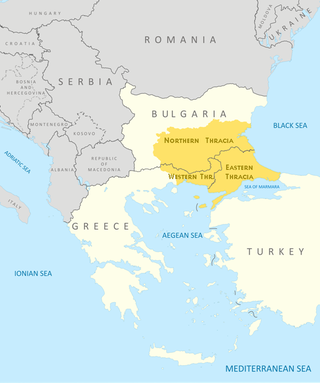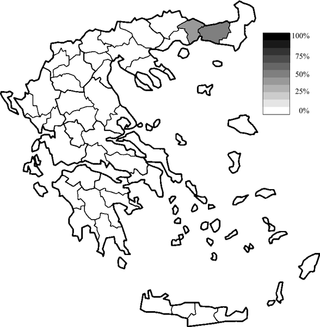Related Research Articles

The Balkan Wars refers to a series of two conflicts that took place in the Balkan states in 1912 and 1913. In the First Balkan War, the four Balkan states of Greece, Serbia, Montenegro and Bulgaria declared war upon the Ottoman Empire and defeated it, in the process stripping the Ottomans of its European provinces, leaving only Eastern Thrace under the Ottoman Empire's control. In the Second Balkan War, Bulgaria fought against the other four original combatants of the first war. It also faced an attack from Romania from the north. The Ottoman Empire lost the bulk of its territory in Europe. Although not involved as a combatant, Austria-Hungary became relatively weaker as a much enlarged Serbia pushed for union of the South Slavic peoples. The war set the stage for the Balkan crisis of 1914 and thus served as a "prelude to the First World War".

Thrace is a geographical and historical region in Southeast Europe. It is split among Bulgaria, Greece, and Turkey, which is bounded by the Balkan Mountains to the north, the Aegean Sea to the south, and the Black Sea to the east. It comprises southeastern Bulgaria, northeastern Greece, and the European part of Turkey. The region's boundaries are based on that of the Roman Province of Thrace; the lands inhabited by the ancient Thracians extended in the north to modern-day Northern Bulgaria and Romania and to the west into the region of Macedonia.

The Thracians were an Indo-European speaking people who inhabited large parts of Southeast Europe in ancient history. Thracians resided mainly in the Balkans but were also located in Anatolia and other locations in the southeast of Europe.

The Second Balkan War was a conflict which broke out when Bulgaria, dissatisfied with its share of the spoils of the First Balkan War, attacked its former allies, Serbia and Greece, on 16 (O.S.) / 29 (N.S.) June 1913. Serbian and Greek armies repulsed the Bulgarian offensive and counter-attacked, entering Bulgaria. With Bulgaria also having previously engaged in territorial disputes with Romania and the bulk of Bulgarian forces engaged in the south, the prospect of an easy victory incited Romanian intervention against Bulgaria. The Ottoman Empire also took advantage of the situation to regain some lost territories from the previous war. When Romanian troops approached the capital Sofia, Bulgaria asked for an armistice, resulting in the Treaty of Bucharest, in which Bulgaria had to cede portions of its First Balkan War gains to Serbia, Greece and Romania. In the Treaty of Constantinople, it lost Adrianople to the Ottomans.

Rumelia, etymologically "Land of the Romans", at the time meaning Eastern Orthodox Christians and more specifically Christians from the Byzantine rite, was the name of a historical region in Southeastern Europe that was administered by the Ottoman Empire, corresponding to the Balkans. In its wider sense, it was used to refer to all Ottoman possessions and vassals in Europe that would later be geopolitically classified as "the Balkans". During the period of its existence, it was more often known in English as Turkey in Europe.

Western Thrace or West Thrace, also known as Greek Thrace, is a geographic and historical region of Greece, between the Nestos and Evros rivers in the northeast of the country; East Thrace, which lies east of the river Evros, forms the European part of Turkey, and the area to the north, in Bulgaria, is known as Northern Thrace.

Islam in Greece is represented by two distinct communities; Muslims that have lived in Greece since the times of the Ottoman Empire and Muslim immigrants that began arriving in the last quarter of the 20th century, mainly in Athens and Thessaloniki. Muslims in Greece are mainly immigrants from The Middle East, other Balkan regions & North Africa.

Turks of Western Thrace are ethnic Turks who live in Western Thrace, in the province of East Macedonia and Thrace in Northern Greece.

The Muslim minority of Greece is the only explicitly recognized minority in Greece. It numbered 97,605 according to the 1991 census, and unofficial estimates ranged up to 140,000 people or 1.24% of the total population, according to the United States Department of State.

East Thrace or Eastern Thrace, also known as Turkish Thrace or European Turkey, is the part of Turkey that is geographically a part of Southeast Europe. It accounts for 3.4% of Turkey's land area but comprises 15% of its total population. The largest city of the region is Istanbul, which straddles the Bosporus between Europe and Asia. East Thrace is of historic importance as it is next to a major sea trade corridor and constitutes what remains to Turkey of the once-vast Ottoman region of Rumelia. It is currently also of specific geostrategic importance because the sea corridor, which includes two narrow straits, provides access to the Mediterranean Sea from the Black Sea for the navies of five countries: Russia, Ukraine, Romania, Bulgaria, and Georgia. The region also serves as a future connector of existing Turkish, Bulgarian, and Greek high-speed rail networks.
The 1934 Thrace pogroms refers to a series of violent attacks against Jewish citizens of Turkey in June and July 1934 in the Thrace region of Turkey. One of the main crucial factors behind the events was the Resettlement Law passed by the Turkish Assembly on 14 June 1934.

The Komotini events occurred on 29 January 1990 between local Greek Christians and members of the ethnic Turkish minority in the Komotini area in northern Greece. The events started over the conviction and imprisonment of an ethnic Turkish MP, Sadik Achmet, by a Greek court. 400 shops were looted, and the offices of two Turkish newspapers ransacked. The clashes broke out after the murder of an ethnic Greek by a Muslim, while there were no Turkish casualties during the events.
Cressa or Kressa was an ancient Greek city located in ancient Thrace, on the Thracian Chersonesus. It is cited in the Periplus of Pseudo-Scylax, in the second position of its recitation of the towns of the Thracian Chersonesus, along with Aegospotami, Cressa, Crithote and Pactya. It may be the same town cited by Pliny the Elder as Crissa on the Propontis.
Paeon or Paion was an ancient Greek city located in ancient Thrace, on the west coast of the Thracian Chersonesus. It is cited in the Periplus of Pseudo-Scylax, in the third position of its recitation of the towns of the Thracian Chersonesus, along with Cardia, Ide, Paeon, Alopeconnesus, Araplus, Elaeus and Sestos.
Athyras was a Greek city in ancient Thrace, located in the region of the Propontis.
Serrion Teichos or Serreion Teichos was a Greek city in ancient Thrace, located in the region of the Propontis. It was a member of the Delian League and appears in tribute lists of Athens between 428/7 and 418/7 BCE. It later bore the name of Ganus or Ganos. It is under this name that the town is mentioned by geographers and historians, as a noted mountain fortress of Thrace.
Tyrodiza was a Greek city in ancient Thrace, located in the region of the Propontis. It appears to have flourished between 550 BCE and 330 BCE, and is identified with the place called Tiristasis in the Periplus of Pseudo-Scylax and Pliny the Elder. It was a member of the Delian League and appears in the tribute lists of ancient Athens between 452/1 and 445/4 BCE. In 340 BCE, Tiristasis was taken by the Athenian general Diopeithes, who enslaved its inhabitants along with those of Crobyle.
The Treaty of Athens between the Ottoman Empire and the Kingdom of Greece, signed on 14 November 1913, formally ended hostilities between them after the two Balkan Wars and ceded Macedonia—including the major city of Thessaloniki— most of Epirus, and many Aegean islands to Greece.
Cobrys or Kobrys was a coastal Greek town in ancient Thrace, on the Thracian Chersonesus. It is mentioned in the Periplus of Pseudo-Scylax
Drabus or Drabos was a coastal Greek town in ancient Thrace, on the Thracian Chersonesus.